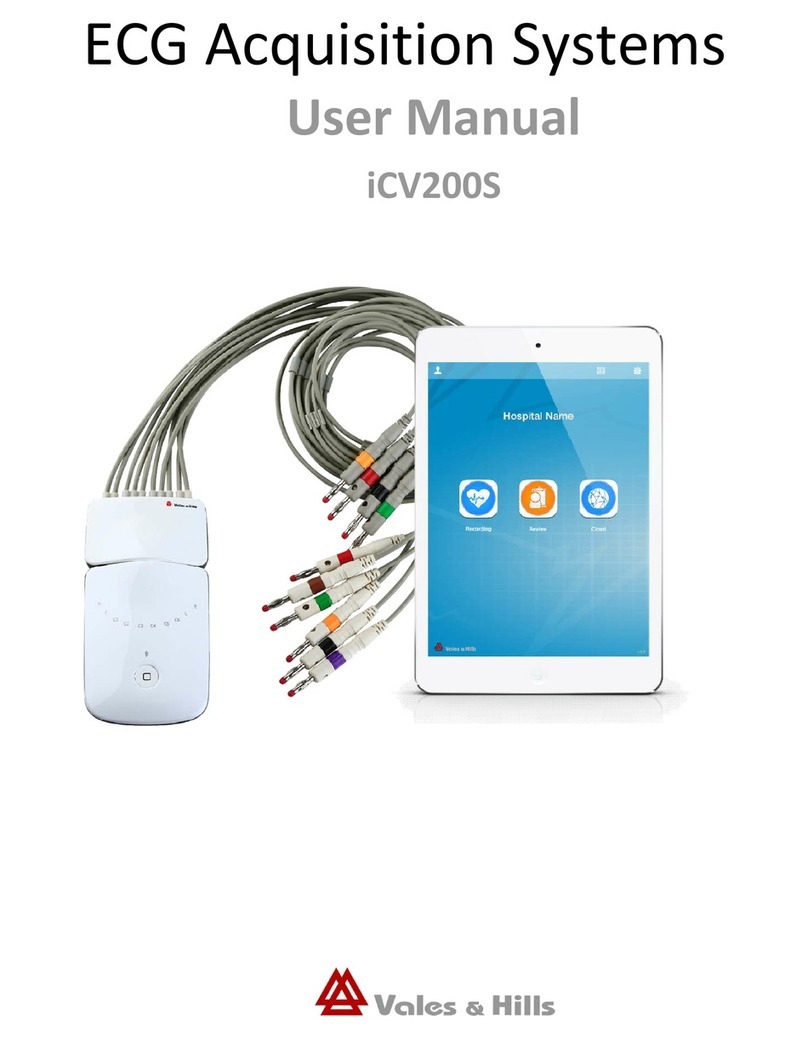
iCV200S User Manual Cardio View®Family
Version: A/1 Page 2 of 58
Like all electronic devices, this electrocardiograph is susceptible to electrostatic discharge (ESD). ESD
typically occurs when electrostatic energy is transferred to the patient, the electrodes, or the
electrocardiograph. ESD may result in ECG artifact that may appear as narrow spikes on the cardiograph
display or on the printed report. When ESD occurs, the electrocardiograph’s interpretation may be
inconsistent with the physician’s interpretation.
V&H assumes no liability for failures resulting from RF or ESD interference between V&H CardioView
series and any RF or ESD generating equipment when these levels exceed those established by
applicable standard.
Warnings
The electrocardiograph has not been designed for use with high frequency (HF) surgical equipment
and does not protect against hazards to the patient.
Ensure the location of the electrode and associated cables provides maximum separation away from
all sources of HF energy. The best way to ensure patient safety is to completely remove all
electrodes and cables from the patient when exposed to HF energy.
Other medical equipment, including but not limited to defibrillators, ultrasound machines,
pacemakers, and other simulators, may be used simultaneously with the electrocardiograph.
However, such devices may disturb the electrocardiograph signal.
Portable RF communications equipment including peripherals such as antenna cables and external
antennas should be used no closer than 30 cm (12 inches) to any part of the device including cables
specified by the manufacturer. Otherwise degradation of the performance of this equipment could
result.
This equipment has been tested and found to comply with the limits for a Class B digital device,
pursuant to part 15 of the FCC Rules. These limits are designed to provide reasonable protection
against harmful interference in a residential installation. This equipment generates uses and can
radiate radio frequency energy and, if not installed and used in accordance with the instructions,
may cause harmful interference to radio communications. However, there is no guarantee that
interference will not occur in a particular installation. If this equipment does cause harmful
interference to radio or television reception, which can be determined by turning the equipment off
and on, the user is encouraged to try to correct the interference by one or more of the following
measures:
- Reorient or relocate the receiving antenna.
- Increase the separation between the equipment and receiver.
- Connect the equipment into an outlet on a circuit different from that to which the receiver is
connected.
- Consult the dealer or an experienced radio/TV technician for help.
This device complies with Part 15 of the FCC Rules. Changes or modifications not expressly
approved by the party responsible for compliance could void the user's authority to operate the
equipment.
Operation is subject to the following two conditions:
(1) This device may not cause harmful interference, and
(2) This device must accept any interference received, including interference that may cause
undesired operation.




























